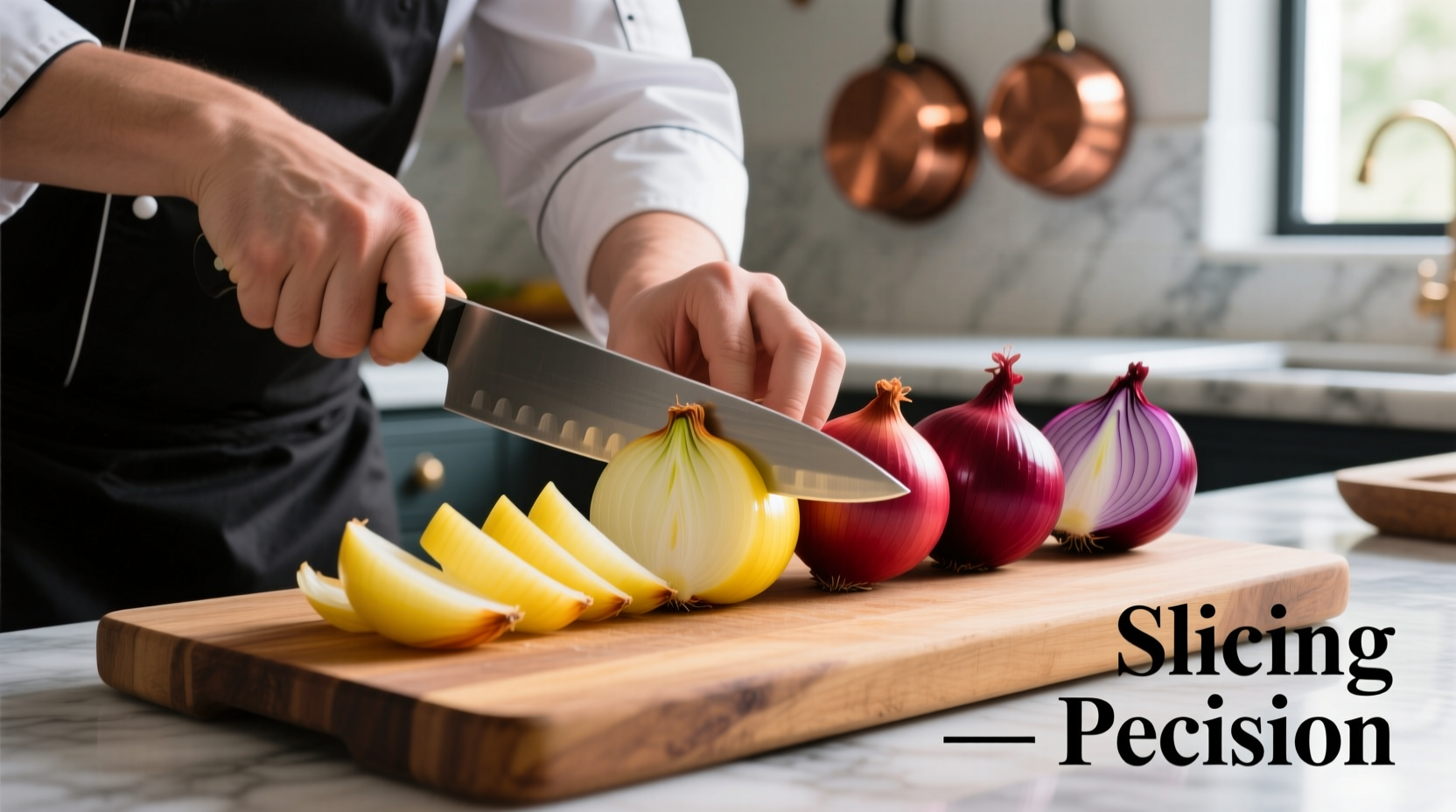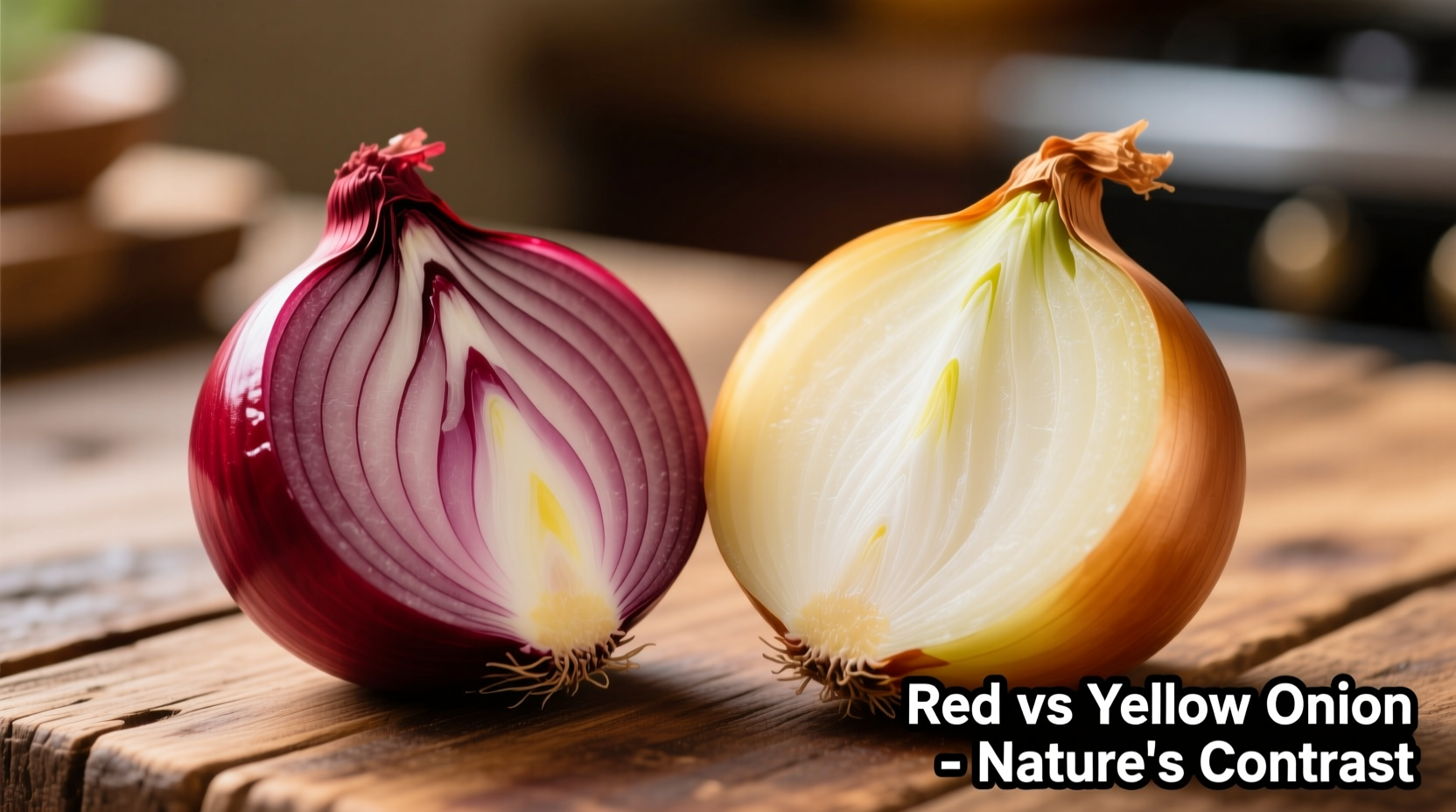Choose yellow onions for cooking and caramelizing due to their higher sugar content and balanced flavor that mellows when heated. Use red onions raw in salads, salsas, and garnishes for their vibrant color and milder, slightly sweeter taste. Never substitute one for the other in critical applications without understanding how it will affect flavor, texture, and appearance of your dish.
Understanding the difference between red and yellow onions isn't just about color—it's about making smarter cooking decisions that elevate your dishes from good to exceptional. As a chef who's worked with thousands of onions across professional kitchens and home cooking demonstrations, I've seen how this simple choice impacts everything from flavor balance to visual presentation. Let's cut through the confusion with practical guidance you can use immediately in your kitchen.
Immediate Decision Guide: Which Onion Should You Reach For Right Now?
When you're standing in the grocery store or staring into your pantry, here's your quick-reference decision tree:
- Grab yellow onions when you're cooking anything that requires heat—soups, stews, sauces, roasts, or caramelizing
- Choose red onions when serving raw—salads, salsas, sandwiches, or as colorful garnishes
- Never substitute red for yellow in French onion soup or caramelized onion applications (the color turns unappetizing)
- Consider white onions only for specific Mexican cuisine applications where their sharper bite is traditional
This immediate guidance works because yellow onions contain approximately 4-5% sugar by weight compared to red onions' 3-4%, according to USDA nutritional data. That seemingly small difference creates dramatically different results when heat is applied.
| Characteristic | Yellow Onions | Red Onions |
|---|---|---|
| Best For | Cooking, caramelizing, soups, stews | Raw applications, salads, salsas, garnishes |
| Flavor Profile | Strong when raw, sweetens beautifully when cooked | Milder when raw, slightly fruitier, loses color when cooked |
| Sugar Content | 4-5% (higher) | 3-4% (lower) |
| Storage Life | 2-3 months in cool, dark place | 3-4 weeks (shorter due to thinner skin) |
| Color When Cooked | Rich golden brown | Turns blue-gray (unappetizing) |
Understanding the Science Behind the Flavor Differences
The distinctive flavors of red versus yellow onions stem from their different sulfur compound profiles. Yellow onions contain higher levels of isoalliin, which transforms into that rich, sweet caramelized flavor when heated. Red onions contain anthocyanins (the same compounds that color blueberries) which provide their purple hue but break down unattractively when cooked.
Food science research from the Journal of Agricultural and Food Chemistry confirms that yellow onions develop more complex flavor compounds during cooking, with higher concentrations of 2-acetyl-1-pyrroline—the compound responsible for that irresistible roasted onion aroma.

When Substitutions Make Sense (and When They Don't)
While yellow and red onions aren't always interchangeable, understanding the boundaries of substitution prevents recipe disasters:
Safe Substitutions
- Using red onion in place of yellow in fresh pico de gallo (the acidity preserves color)
- Using yellow onion in place of red in cooked applications where color doesn't matter
- Soaking sliced red onions in ice water for 10 minutes before using in salads to reduce sharpness
Risky Substitutions to Avoid
- Using red onions for caramelizing (turns unappetizing blue-gray)
- Using yellow onions raw in delicate salads (overpowering flavor)
- Substituting in French onion soup (yellow is essential for proper color development)
- Using red onions in potato salad (color bleeds into other ingredients)
Professional chefs at the Culinary Institute of America note that the most common substitution mistake they see home cooks make is using red onions in cooked applications where yellow onions would provide superior flavor development. The visual appeal of red onions tempts many cooks, but the chemistry doesn't lie—yellow onions simply caramelize better.
Maximizing Flavor in Your Cooking: Practical Applications
Now that you understand the fundamental differences, let's apply this knowledge to real cooking scenarios:
For Perfect Caramelized Onions
Yellow onions are the undisputed champion. Their higher sugar content and sulfur profile create that deep, complex sweetness without bitterness. Cook slowly over medium-low heat for 45-60 minutes, stirring occasionally. Adding a pinch of baking soda (1/16 teaspoon per pound of onions) raises the pH slightly, accelerating the Maillard reaction for faster caramelization without burning.
For Vibrant Fresh Salsas and Salads
Red onions shine when raw. Their thinner layers slice more cleanly, and their milder flavor won't overpower delicate ingredients. For the best results, slice red onions thinly and soak in cold water with a splash of vinegar for 10-15 minutes before using—this removes excess sharpness while preserving crunch and color.
For French Onion Soup
This classic dish requires yellow onions exclusively. Their flavor profile develops the proper golden-brown color and rich umami base that defines authentic French onion soup. Attempting this with red onions results in an unappetizing gray-brown color and off-flavors.
Storage Tips to Extend Freshness
Proper storage significantly extends onion shelf life:
- Store both types in a cool, dark, well-ventilated place (not the refrigerator)
- Yellow onions last 2-3 months; red onions last 3-4 weeks due to thinner skin
- Never store onions near potatoes (they emit gases that spoil each other)
- Once cut, wrap unused portions tightly in plastic and refrigerate for up to 7 days
According to USDA storage guidelines, the ideal storage temperature for onions is between 45-55°F (7-13°C) with low humidity. Higher temperatures accelerate sprouting, while refrigeration causes moisture buildup that promotes spoilage.
Nutritional Comparison: Health Benefits Compared
Both onion varieties offer significant health benefits, but with some notable differences:
- Red onions contain anthocyanins, powerful antioxidants also found in blueberries
- Yellow onions have slightly higher quercetin content, associated with reduced inflammation
- Both provide vitamin C, B vitamins, and chromium for blood sugar regulation
- Raw consumption preserves more nutrients than cooked
Research published in the Journal of Food Science shows red onions contain up to 10 times more antioxidant anthocyanins than yellow onions, making them particularly valuable in raw applications where these compounds remain intact.
Professional Chef Tips You Won't Find Elsewhere
After years working in professional kitchens, here are my insider techniques:
- When making onion rings, use yellow onions for better batter adhesion and sweeter flavor
- For Bloody Marys, muddle red onion with celery for a beautiful pink hue and complex flavor
- When substituting red for yellow in cooked dishes, add 1/4 teaspoon of sugar per onion to compensate for lower sugar content
- Freeze caramelized yellow onions in ice cube trays for instant flavor boosters in soups and stews
Remember that onion quality matters as much as variety selection. Choose firm onions with dry, papery skins and no soft spots. The heavier the onion feels for its size, the higher the moisture content and freshness.
Final Verdict: Making the Right Choice Every Time
The red versus yellow onion debate isn't about which is "better"—it's about matching the right tool to the job. Yellow onions are your workhorses for cooking, while red onions are your colorful accents for raw applications. Understanding this fundamental distinction transforms your cooking from hit-or-miss to consistently excellent.
Next time you're planning a meal, consider the onion's journey from raw ingredient to finished dish. Will it be cooked or served raw? Does color matter in the final presentation? How much sweetness do you need? Answering these questions before you shop ensures you bring home the perfect onion for your culinary creation.











 浙公网安备
33010002000092号
浙公网安备
33010002000092号 浙B2-20120091-4
浙B2-20120091-4